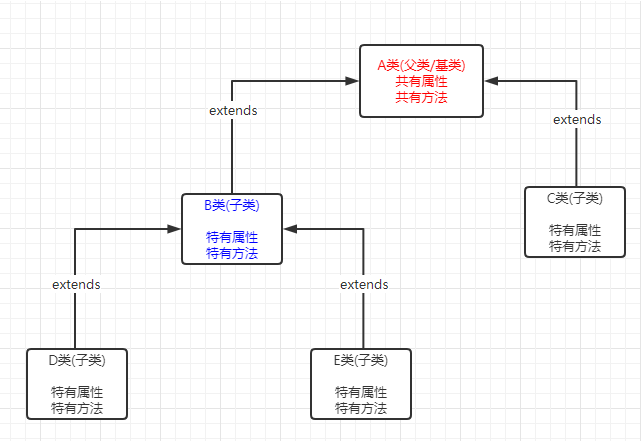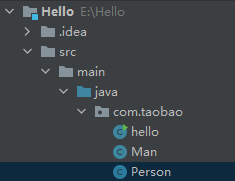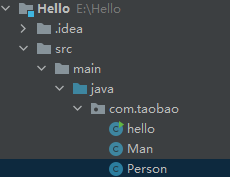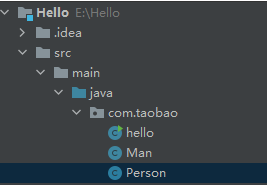1. Inheritance overview
- Inheritance: solve code reuse. When multiple classes have the same attributes (variables) and methods, you can abstract the parent class from these classes and define the same attributes and methods in the parent class. All subclasses do not need to redefine these attributes and methods, but only need to inherit the parent class through extensions
(1) Inheritance grammar
class Subclass extends Parent class{
}
/*
1,The subclass will automatically have the properties and methods defined by the parent class;
2,The parent class is also called super class and base class;
3,Subclasses are also called derived classes
*/
- Inheritance diagram

(2) Introduction to inheritance
- The contents are as follows:

① Create parent class
package com.taobao;
public class Person {
public String name; //Public name
private int age; //age privatization
private double salary; //..
//alt+insert
public Person() {
}
public Person(String name, int age, double salary) {
this.name = name;
this.age = age;
this.salary = salary;
//Write the set method in the constructor so that it can still be verified
setSalary(salary);
setName(name);
setAge(age);
}
public String getName() {
return name;
}
public void setName(String name) {
//1. Adding data verification is equivalent to adding default logic
if(name.length() >=2 && name.length()<=6) {
this.name = name;
} else {
System.out.println("The length of the name is incorrect,Requires 2 to 6 characters, default name");
this.name = "Youth re-enter";
}
}
public int getAge() {
return age;
}
public void setAge(int age) {
if(age>=1 && age <= 120) {
this.age = age;
}else{
System.out.println("Wrong age setting,Need in(1-120),Give default age 18");
this.age = 18; //Give a default age
}
}
public double getSalary() {
return salary;
}
public void setSalary(double salary) {
this.salary = salary;
}
//Write a method to return attribute information
public String info(){
return "Information is name =" + name + "age = " + age + "Salary is =" + salary;
}
}
② Create subclasses
package com.taobao;
public class Man extends Person {
public void testing(){
System.out.println(name);
}
}
③ Subclass of main method call
package com.taobao;
public class hello {
public static void main(String[] args) {
Man man = new Man();
man.name = "Zhang San";
man.testing();
}
}
- Operation results

2. Inheritance details
2.1. Subclasses inherit all properties and methods
① Non private properties and methods can be accessed directly in subclasses;
② Private properties and methods cannot be accessed directly in subclasses, but through public methods;
- Example: the directory structure is as follows

(1) Parent class Person creation
public class Person {
public String name;
private double salary; //..
//alt+insert
public double getSalary() {
return salary;
}
public void setSalary(double salary) {
this.salary = salary;
}
//Write a public property and return a public information
public String info(){
return "Salary is =" + salary;
}
//Write a private method
private void info2(){
System.out.println("full name:" + name);
}
//callTest
public void callInfo2(){
info2();
}
}
(2) The subclass Man inherits the parent class of Person
public class Man extends Person {
public void testing(){
System.out.println(name);
}
}
(3) The main method uses subclasses
public class hello {
public static void main(String[] args) {
Man man = new Man();
//1. Subclasses inherit non private properties - can be accessed directly
man.name = "Zhang San";
//2. Subclasses inherit private properties - provide public methods (get) to access properties through the parent class
man.setSalary(1000);
//3. Class inherits the public method of the parent class - you can access it directly
System.out.println(man.info());
//4. Subclasses inherit the private methods of the parent class - access private methods by providing public methods in the parent class
man.callInfo2();
//5. Methods that directly access subclasses
man.testing();
}
}
- Operation results

2.2. The subclass must call the parent class constructor to complete the initialization of the parent class
-
When creating a subclass object, no matter which constructor of the subclass is used, the parameterless constructor of the parent class is always called by default
- There is a super() in the parameterless constructor of the subclass by default, representing the parameterless constructor calling the parent class;
- When creating a subclass object, no matter which constructor of the subclass is used, the parameterless constructor of the parent class is called by default
-
Example: the directory structure is as follows

① Create parent class
package com.taobao;
public class Person {
//Parent constructor
public Person() {
System.out.println("Call the constructor of the parent class...");
}
}
② Create subclasses
package com.taobao;
public class Man extends Person {
//Subclass constructor
public Man() {
//super(); // By default, the parameterless constructor of the parent class is called
System.out.println("Parameterless constructor for subclasses...");
}
public Man(String name){
//super();
System.out.println("parameter"+name);
}
}
③ The main method creates a subclass object
package com.taobao;
public class hello {
public static void main(String[] args) {
Man man = new Man();
}
}
- Run result: create the parent class first and then the child class

2.3. The parent class does not provide a parameterless constructor
-
Note: you must use super in the constructor of the subclass to specify which constructor of the parent class is used to complete the initialization of the parent class, otherwise the compilation will not pass;
-
Example: the directory structure is as follows

① Create parent class
package com.taobao;
public class Person {
public Person(String name) {
System.out.println("Call the constructor of the parent class...");
}
}
② Create subclasses
package com.taobao;
public class Man extends Person {
public Man() {
super("Zhang San");
System.out.println("Parameterless constructor for subclasses...");;
}
public Man(String name) {
super("Zhang San");
System.out.println("Parameterized constructor of subclass...");;
}
}
③ Create an object and call the parameterless constructor and the parameterless constructor of the subclass respectively
package com.taobao;
public class hello {
public static void main(String[] args) {
System.out.println("Call subclass parameterless constructor!");
Man man = new Man();
System.out.println("Call the parameterized constructor of the subclass!");
Man man1 = new Man("lizhi");
}
}
- Operation results

- matters needing attention
- ① If you want to specify to call a constructor of the parent class, call it explicitly: Super (parameter list)
- ② When using super, it needs to be placed in the first line of the constructor
- ③ Both super() and this() can only be placed on the first line of the constructor, so the two methods cannot have the same constructor
- ④ All classes in java are the parent class of object, and object is the base class of all classes;
- ⑤ The call of the parent constructor is not limited to the direct parent class! The Object class (top-level parent class) will always be traced back to the top
- ⑥ Subclasses inherit at most one parent class, that is, single inheritance in java: how to make class A inherit B and C, first let class B inherit C, and then let class A inherit B
- ⑦ Inheritance cannot be abused, and the logical relationship between subclass and parent must meet is-a;
3. The essence of inheritance
- example
(1) New class GradPa
package com.taobao;
public class GrandPa {
String name = "grandpa";
String hobby = "Travel";
}
(2) New subclass Father inherits GradPa class
package com.taobao;
public class Father extends GrandPa {
String name = "Big head Dad";
int age = 39;
}
(3) New subclass Son inherits Father
package com.taobao;
public class Son extends Father{
String name = "Big head son";
}
(4) The main method creates a subclass object
package com.taobao;
public class hello {
public static void main(String[] args) {
Son son = new Son();
System.out.println("call Son Subclass name:"+son.name);
System.out.println("call Father Parent class age:"+son.age);
System.out.println("call GrandPa Parent class hobby:"+son.hobby);
}
}
- Operation results

- Attribute search order: returns information according to the search relationship
- ① First, check whether the subclass has this attribute;
- ② If the subclass has this attribute and can be accessed, the information is returned;
- ③ If the child class does not have this attribute, it depends on whether the parent class has this attribute (if the parent class has this attribute and can access it, it returns information)
- ④ If there is no parent class, continue to find the parent class and know the Object according to the rule in (3)
- ⑤ If the private attribute is found upward, the get method is called;
4. super keyword
- super: represents the reference of the parent class, which is used to access the properties, methods and constructors of the parent class
- Explicitly call the parent class constructor in the subclass constructor
- Access member methods and variables of the parent class.
(1) super basic syntax
① Access the property of the parent class, but cannot access the private property of the parent class;
super.attribute
② Access the method of the parent class, but cannot access the private method of the parent class;
super.Method name(parameter list)
③ Accessing the constructor of the parent class, but it can only be placed in the first sentence of the constructor, which conflicts with this;
super(parameter list)
(2) super calls the parent class constructor
When creating a subclass object, no matter which constructor of the subclass is used, the parameterless constructor of the parent class is always called by default,
There is one in the parameterless constructor of subclass by default super(),Represents the parameterless constructor that calls the parent class;
When creating subclass objects,No matter which constructor of the subclass is used, the parameterless constructor of the parent class is called by default
(3) super calls the parent class attribute
- When the parent and child classes have the same data members, the JVM may be ambiguous and need to be specified with super
- Example 1 - find nearby without super
//1. Create parent class
class Person {
int age = 12;
}
//2. Create subclasses
class Student extends Person {
int age = 18;
void display() {
System.out.println("Student age:" + age);
}
}
//3. Create test class
class Test {
public static void main(String[] args) {
Student stu = new Student();
stu.display();
}
}
- Operation results

- Example 2: add super to follow the parent class
//1. Create parent class
public class Person {
int age = 12;
}
//2. Create subclasses
public class Student extends Person {
int age = 18;
void display() {
System.out.println("Student age:" + super.age);
}
}
//3. Create test class
public class Test {
public static void main(String[] args) {
Student stu = new Student();
stu.display();
}
}
- Operation results

(4) super calls member methods
-
When the parent class and child class have the same method name, you can use the super keyword to access the methods of the parent class;
-
example:
//1. Create parent class
class Person {
void message() {
System.out.println("This is person class");
}
}
//2. Create subclasses
class Student extends Person {
void message() {
System.out.println("This is student class");
}
void display() {
message(); // Call the message method of the current class
super.message(); // Call the message method of the parent class
}
}
//3. main call subclass
class Test {
public static void main(String args[]) {
Student s = new Student();
s.display();
}
}
- Operation results
- Only the method message() is called, which means that the current class message() is called;
- When using the super keyword, message() which is the parent class is called.

(5) The difference between super and this
| Distinguishing points | this | super | |
|---|---|---|---|
| 1 | Access properties | Access the attribute in this class. If there is no such attribute in this class, continue to find it from the parent class | Direct access to properties in the parent class |
| 2 | Call method | Access the method in this class. If there is no such method in this class, it will inherit from the parent class | Direct access to methods in the parent class |
| 3 | Invoking Constructors | When calling this class constructor, it must be placed in the first line of the constructor | **Directly call the parent class constructor, * * must be placed in the first line of the constructor |
| 4 | special | Represents the current object | Accessing parent objects in subclasses |
5. Method override
(1) Overview of method rewriting
- Method Rewriting: if a method in a subclass has the same name, return type and parameters as a method of the parent class, then we say that the method of the subclass overrides the method of the parent class;
//1. Create parent class
public class Animal {
public void cry(){
System.out.println("Animal barking...");
}
}
//2. Create subclasses
public class Dog extends Animal {
public void cry(){
System.out.println("The dog barked...");
}
}
//3. Subclass of main method call
public class OverrideMain {
public static void main(String[] args) {
//Demo method override
Dog dog = new Dog();
dog.cry();
}
}
- Operation results

(2) Method override details
I. the parameter and method name of the subclass method should be exactly the same as the parameter and method name of the parent method;
II. Return type of subclass method
-
The method return type of the parent class is the same;
-
The subclass of the return type of the parent class;
//Parent class
public object getInfo()
//Subclass
public String getInfo()
III. subclass methods cannot reduce the access rights of parent methods
//Parent class void sayOk() //Subclass public void sayOk()
(3) The difference between method rewriting and method overloading
| name | Occurrence range | Method name | parameter list | Return type | Modifier |
|---|---|---|---|---|---|
| heavy load | This category | Must be the same | At least one different type, number and order | No requirement | No requirement |
| rewrite | Parent child class | Must be the same | Must be the same | Consistent / parent-child class | Subclass > parent access range |